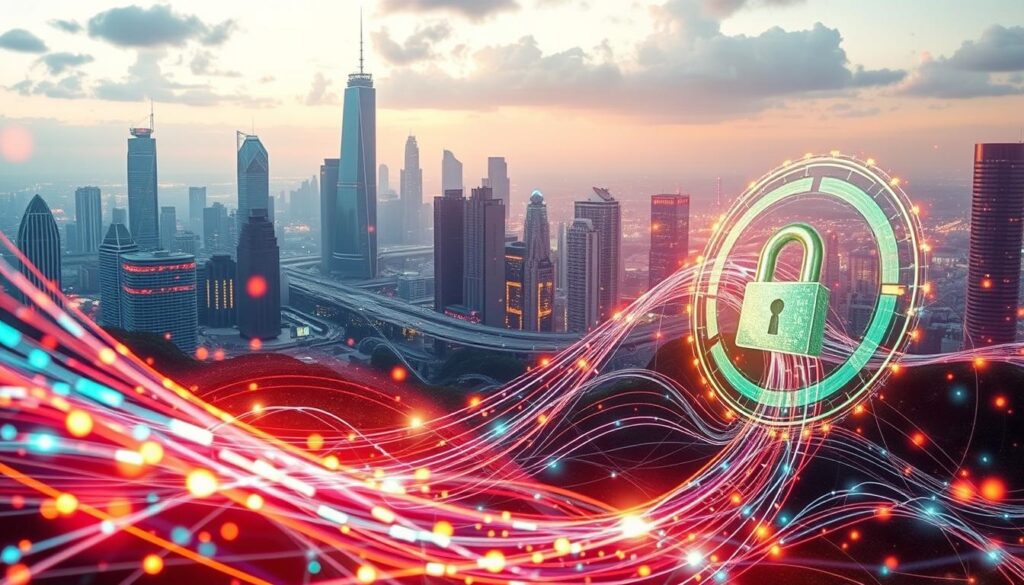I’m excited to explore the cutting-edge world of email security ai. As cyber threats evolve, so do our defenses. The landscape of digital protection is shifting rapidly, with artificial intelligence leading the charge.
In today’s digital age, email remains a prime target for cybercriminals. Phishing emails account for a staggering 90% of all cyberattacks on organizations1. This alarming statistic underscores the urgent need for robust email security measures.
AI is revolutionizing how we combat these threats. The market for AI in cybersecurity is set to reach $46.3 billion by 2027, growing at an impressive rate of 23.6% annually1. This growth reflects the increasing reliance on AI-powered solutions to protect our digital communications.
The rise of AI has not only bolstered our defenses but also empowered cybercriminals. Reports indicate that 70% of attacks are now automated through AI technologies1. This dual-edged sword of AI in cybersecurity presents both challenges and opportunities for email protection.
As we dive deeper into AI-driven email security, we’ll explore how these innovations are reshaping threat detection, authentication methods, and encryption technologies. The future of email security is here, and it’s powered by AI.
Key Takeaways
- Phishing emails constitute 90% of cyberattacks on organizations
- AI in cybersecurity market projected to reach $46.3 billion by 2027
- 70% of cyberattacks are now automated using AI
- 75% of workers are using AI to automate tasks and communications2
- AI-driven malware is becoming increasingly difficult to detect
AI Email Security Trends Transforming Threat Detection
I’m excited to explore how AI is changing email security. The world of digital threats keeps changing, and AI is leading the fight against these dangers.
Real-time Pattern Analysis and Prevention
AI is making email security better by catching threats fast. This means organizations can act quickly to protect themselves3.
Machine Learning (ML) looks at lots of email data to spot bad patterns. Natural Language Processing (NLP) checks emails for signs of phishing by looking at the words and how they’re used3.
Predictive Analytics for Proactive Defense
Predictive analytics helps predict and stop email threats before they happen. This way, organizations can stay ahead of attacks3.
AI can also watch how people interact with emails to find and block threats. It uses real-time data to stay ahead of new threats3.
Machine Learning-Powered Spam Filtering
AI email filters sort emails to keep the good ones coming and block the bad ones. These filters are very good at catching threats and don’t mistake good emails for bad ones3.
| AI Email Security Feature | Benefit |
|---|---|
| Real-time Pattern Analysis | Reduces vulnerability window |
| Predictive Analytics | Anticipates emerging threats |
| Machine Learning-Powered Filtering | Improves accuracy, reduces false positives |
By using these AI tools, companies can make their email security stronger and more effective. The use of AI for spam detection and filtering is a big step in fighting digital threats.
Zero Trust Architecture and Advanced Authentication
Email security AI is changing how we handle authentication and access control. The Zero Trust model treats all network traffic as untrusted until it’s verified. This makes email security stronger. It’s key because 95% of data breaches are due to human mistakes4.
Multi-factor Authentication Evolution
Multi-factor authentication has grown beyond just passwords. Now, we see more biometric methods and hardware tokens. These advanced methods are crucial, as 79% of IT leaders say collaboration tools are new threats4.
Behavioral Analytics Integration
Behavioral analytics adds a layer of security by checking user patterns. This is important because 74% of organizations face AI-powered cyber threats5. By using these analytics, we can spot unusual activity better.
Continuous Identity Verification
Continuous identity verification keeps security up throughout a user’s session. This is key, as 89% of organizations see AI threats as ongoing challenges5. It’s a way to stay ahead of cyber threats.
| Authentication Method | Adoption Rate | Security Level |
|---|---|---|
| Multi-factor Authentication | High | Very High |
| Behavioral Analytics | Medium | High |
| Continuous Identity Verification | Low | Extremely High |
These advanced authentication methods help make email security better. With 95% of organizations using AI for cybersecurity4, email security AI is leading the way in this changing field.
Next-Generation Email Encryption Technologies

I’ve seen a big change in email security. The global email encryption market is growing fast. It’s valued at $7.75 billion in 2024 and could hit $40.16 billion by 2033. This shows how important strong email spam check systems and new encryption are.
End-to-end encryption is now the top choice for email security. It makes sure only the right person can read your email. They use their own private key to unlock the message. This method greatly lowers the chance of data leaks and unauthorized access.
Quantum-safe cryptography is a new, smart solution. It’s designed to keep emails safe from future quantum computers. This tech is key as we get ready for a world where old encryption won’t work anymore.
| Technology | Key Feature | Benefit |
|---|---|---|
| End-to-end Encryption | Private Key Decryption | Enhanced Privacy |
| Quantum-safe Cryptography | Post-quantum Security | Future-proof Protection |
| AI-integrated Encryption | Adaptive Security | Real-time Threat Response |
AI is being used with encryption to make security even better. These systems can change fast to fight new threats. In 2022, 75% of companies faced a successful email attack, costing an average of $1,000,0006. This shows we really need these new encryption methods.
As we look ahead, using these new technologies is key. They help us fight today’s threats and get ready for tomorrow’s challenges in cybersecurity.
Enhanced Security Gateway Solutions
Email security has grown beyond just blocking spam. Today, Security Gateway Solutions (SEGs) protect against many threats. Let’s look at the advanced features of modern SEGs, key to a strong email security plan.
Cloud-based Security Integration
Cloud-based security is changing how we protect emails. It offers flexible, scalable protection for all businesses. With 350 billion emails sent and received daily, strong security is essential7.
Cloud and API-based solutions are flexible and customizable. They help businesses quickly respond to new threats7.
Sandboxing and Threat Neutralization
Sandboxing is a key feature of modern SEGs. It safely analyzes emails before they reach users. This is vital, as 58% of threats slip past traditional security7.
Advanced filtering and verification systems reduce phishing and BEC threats8.

Data Loss Prevention (DLP) Capabilities
Data Loss Prevention is getting better at stopping sensitive info from being sent out. With a 135% rise in social engineering attacks, DLP is more important than ever7.
AI-powered solutions can spot and block threats 13 days faster than old tools7.
Looking ahead, AI in email security will play a bigger role. By 2028, 50% of companies will use AI to fight BEC threats, up from 5% today8. This move to AI-enhanced security promises a stronger defense against more threats.
Conclusion
As I conclude this look at email security AI trends, it’s clear the field is changing fast. AI systems are now key in spotting threats, checking billions of emails for odd patterns instantly9. This is vital, as 75% of companies faced email attacks in 202210.
The future of email security is about using many different methods. Zero Trust architecture is becoming popular, focusing on better identity checks through MFA and watching user behavior9. The MFA market is expected to hit $20 billion by 2025, showing its big role10. Advanced email security steps are now a must as cyber threats get smarter.
Looking forward, I think AI will play an even bigger part in email security. Almost 69% of companies think they can’t fight cyber threats without AI, and 63% of breaches are caught in minutes with AI in security10. As we move into this new email security era, keeping up and using strong AI security will be crucial. It will help protect our digital talks from the constant cyber threats.
FAQ
How is AI revolutionizing email threat detection?
What is Zero Trust Architecture in email security?
How are encryption technologies evolving for email security?
What are Security Gateway Solutions?
How does AI-powered spam filtering work?
What is behavioral analytics in email security?
How does sandboxing contribute to email security?
Source Links
- Email Security in 2024: A Look at Three Emerging Trends – https://guardiandigital.com/resources/blog/email-security-in-2024
- The Future of AI Security: Three Trends Every Executive Should Watch – Palo Alto Networks Blog – https://www.paloaltonetworks.com/blog/sase/the-future-of-ai-security-three-trends-every-executive-should-watch/
- The role of AI in email security enhancement | Acronis – https://www.acronis.com/en-eu/blog/posts/ai-email-security/
- Human risk has surpassed technology gaps as the biggest cybersecurity challenge for organizations around the globe as demonstrated in the findings of our SOHR 2025 Report. – https://www.mimecast.com/the-state-of-email-and-collaboration-security-2024/
- Email Security Threats | Trends & Solutions | Darktrace – https://darktrace.com/cyber-ai-glossary/the-most-common-email-security-threats
- 2023 email security trends – https://www.barracuda.com/reports/email-security-trends-report-2023
- Enhancing Email Security | Best Tools & Practices | Darktrace – https://darktrace.com/cyber-ai-glossary/the-best-tools-for-enhancing-email-security
- Gartner Technology Trends 2025: AI in Cybersecurity & Email Se – https://guardiandigital.com/resources/blog/gartners-top-tech-trends-security-considerations-2025
- Future Trends in Email Security and Collaboration: What’s Next? – https://mailsafi.com/blog/future-trends-in-email-security-and-collaboration-whats-next/
- Top Email Security Trends for 2024 – https://www.mxlayer.com/blog/email-security/top-email-security-trends-for-2024/